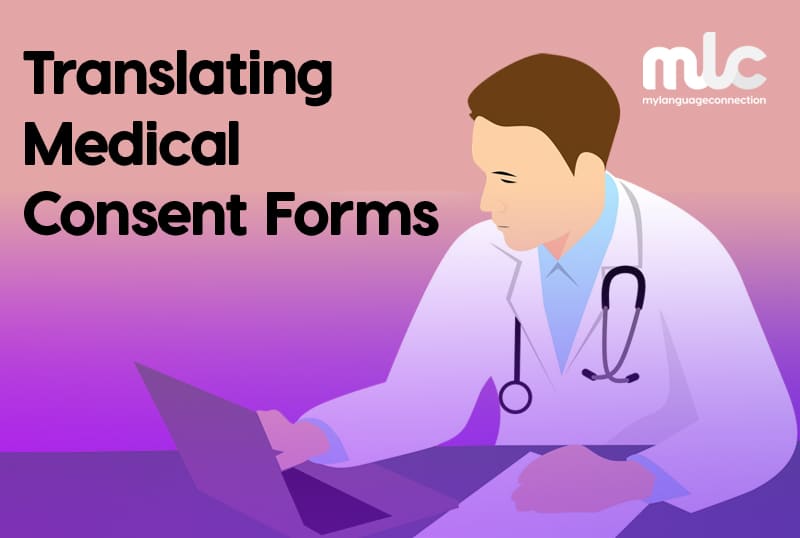Translating medical consent forms is an essential step to make information more accessible to patients, as well as to ensure patient safety and meet regulatory compliance.
Accurate and transparent communication is vital in the health and medical field. Any form of miscommunication could put patients’ lives at risk. For this reason, translating medical consent forms must be set to the highest standards to avoid these risks. This move also leans toward a growing trend in the industry, which is patient empowerment. Patients now have more control over their diagnosis and treatment than they did before. This is just one step towards that direction, but a crucial one at that.
 What is Informed Medical Consent?
What is Informed Medical Consent?
An informed medical consent form is a requirement in the healthcare and medical setting. This applies to patients who are subject to undergo a clinical trial study or any healthcare procedures. It is a must that patients are properly and adequately informed of the procedure they are about to undergo and its entailing risks.
The idea of an informed medical consent is that the patient is made aware of the procedure and the consequences. Therefore, they can use that information to decide if they are willing to participate or not. It is the patient’s right to be informed before they can give consent.
A typical medical consent form must include any, but are not limited to, the following information:
- Summary of the study or procedure
- Objectives of the study or procedure
- Duration and schedule
- The processes involved
- Potential benefits
- Possible side effects
- Rights and responsibilities of the participant
Fulfilling the requirements of an informed medical consent guarantees that the patient voluntarily undergoes the clinical study or the medical procedure. This ensures that you meet the legal and ethical standards for the procedure.
 The Purpose of Medical Consent Forms
The Purpose of Medical Consent Forms
Based on the definition above, the purpose of an informed medical consent form is to make patients of a medical procedure or participants of a clinical study be aware of the implications of the procedure to be undergone. Its main purpose is to inform.
This is important in situations when patients have apprehension of the procedure they are about to go through. This medical document provides information when patients or participants have questions about the process. It will not only increase patient engagement, but also ensures that the procedure follows legal and ethical standards.
How Does Translation Factor in Medical Consent Forms?
Translating medical consent forms is important when dealing with patients who do not speak or understand the English language. Just because a patient does not fully understand the process, it does not take away their right to know.
Translating medical consent forms is vital, especially for clinical research studies done on a global scale. This often involves collaboration between various international institutions. Effective communication can be a huge factor in the success of the study.
Overcoming language barriers is just one of the challenges present in conducting clinical studies or performing medical procedures on patients. With more clinical studies being done in developing countries (or non-English speaking countries), the demand for translation services of medical documents such as medical consent forms is growing.
Moreover, you need to translate the document to protect the rights of patients. A full and clear understanding of these documents is only possible with language translation, or when it is written in their own language.
Challenges When Translating Medical Consent Forms
The obvious challenge when translating medical consent forms is how to deliver the information that would make it easy to understand for anyone who doesn’t have medical knowledge. Medical documents and journals are known for their use of medical jargon that many of those who are not healthcare professionals are unable to grasp. Therefore, the document must not only be filled with the relevant information but also presented in a simplified manner.
This is easier said than done when you need to present technical or scientific knowledge. You can achieve this by working with a medical translator that has subject expertise in the medical field. You have to make sure that the information contains all the necessary information while making it accessible.
 Guidelines for Translating Medical Consent Forms
Guidelines for Translating Medical Consent Forms
Hiring an experienced and qualified medical translator is the first step to ensure that you follow the guidelines of translation for medical consent forms. It is also important to follow the preferred methods of translation that are accurate and complete.
When translating, always use short and direct sentences. This makes the medical text easier to understand and absorb for the reader.
It is also recommended that you adapt the terminology suited within the context of the clinical study or medical procedure. Use simple explanations for complex procedures or when dealing with specialised terms. Always choose clear language, whenever possible.
You must eliminate redundancies that could lead to confusion. Also, refrain from using acronyms and abbreviations in the text.
A technique known as back translation is also recommended, in some cases. Back translation is a form of additional quality assurance procedure, especially when dealing with complicated clinical trials or those with specialised risks. Back translation is when an independent translator will review and evaluate the translated medical consent form. The independent translator must be void of knowledge or contact with the original text. The goal of doing back translation is to ensure the consistency and quality of the translated document.
Risks Involved When Translating Medical Consent Forms
Clinical trials are important in the development of new medicines and procedures. Meanwhile, medical procedures are important because they put the patient’s health and life at risk. Real lives are involved and could be at risk
Even in first-world countries like the UK and the US, there is a high level of diversity in the population. It is important to take this part of the population in mind by providing translated medical consent forms in various languages.
Proper translation is crucial to mitigate the risk. It is also a matter of ethical and legal concern. Access to accurate and correct translation is vital to uphold the rights of the patients and their health and welfare.

